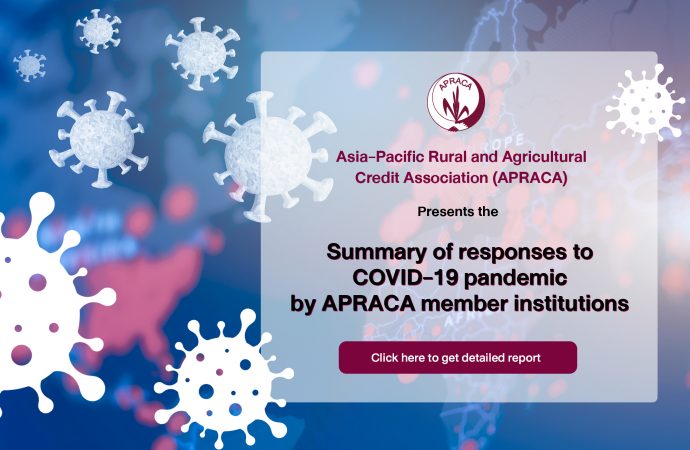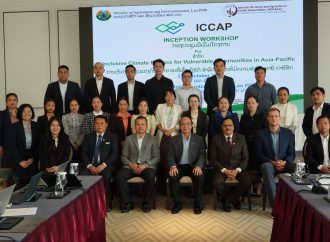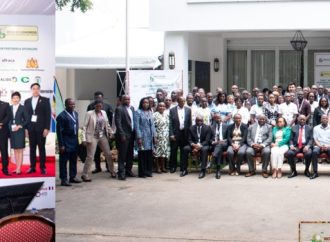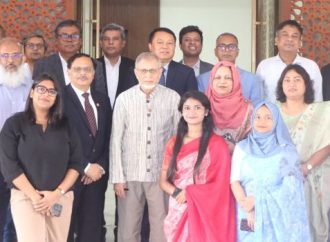Asia-Pacific Rural and Agricultural Credit Association (APRACA) Summary of responses to COVID-19 pandemic by APRACA member institutions (reported as on 20 April 2020) APRACA during the last 4 weeks conducted a survey to understand the preparedness and responses of APRACA members across the region to understand the followings: What is the impact of COVID-19
Asia-Pacific Rural and Agricultural Credit Association (APRACA)
Summary of responses to COVID-19 pandemic by APRACA member institutions
(reported as on 20 April 2020)
APRACA during the last 4 weeks conducted a survey to understand the preparedness and responses of APRACA members across the region to understand the followings:
- What is the impact of COVID-19 that you are expecting on the agricultural sector in your country (macro level)?
- How the supply of finance to agriculture and allied sectors are being impacted due to COVID-19 (both Macro and micro level)?
- What are the responses by your organization to reach out to your customers engaged in agriculture and allied business?
- What are the policy measures taken by the national government and central banks to ease the impact of COVID-19 on agricultural finance?
We received responses from 14 Institutions from 9 countries which are compiled and presented below:
South Asia: India (NABARD and State Bank of India), Nepal (ADBL and NCBL) and Pakistan (State Bank of Pakistan)
Southeast Asia: Philippines (ACPC, KMBI), Thailand (BAAC), Laos (APB) and Vietnam (VBARD, VBSP)
East Asia: Japan (JFC) and China (ADBC and HTRCB)
The details of the observations from financial institutions are provided below:
The farming communities all across the countries in Asia-Pacific region continues to deal with the impacts of the ongoing coronavirus pandemic (COVID-19). The farm labourers and others have already lost their regular incomes as a result of the crisis and the agricultural inputs are in high demand. The current crisis also impacting the small businesses in the downstream of the value chains and it is expected that there will be unprecedented increase in agricultural commodity prices eventually lead to food security concerns for the country. The government and private sectors are responding through various disaster relief programme and providing support to the smallhloder producers impacted directly or indirectly by this global pandemic which however are not sustainable for long term agricultural development and achieving the food security.
The current situation needs specific provisions of investment targeting the farming community who are playing important roles in the local food systems and to ensure emergency supply. The investments may target initially for the (a) all smallhloder farmers by providing necessary inputs, provisioning of markets (including procurements), insurances, access to agricultural technologies etc.; (b) livestock producers (including dairy) to ensure stabilizing their markets; (c) value chain actors active in local food systems for developing farmers markets, retail markets, restaurants, and supply of school meals etc.
Agricultural finance in major Asian economies historically targeted smallholder farmers, which however not impacted much to enhance their income and capacity since last 3 decades. It was also observed that the value chains of the local and regional agricultural markets are not developed enough to support the specialty crop producers, or smaller-scale farmers who have fewer resources to draw on in times of economic stress or uncertainty like the current situation. While the governments responded to this emergency promptly by extending cash benefits, subsidized interest rates and collateral free lending to aid farm growers alongside the financial institutions, the lack of specific financing instruments in this sector poses a significant challenge in implementing the government intention of sustainable development goals and provide long term solution to this economic crisis. Most of the countries are mastering many resources to support the farm sector (including SMEs) in their own ways by using may types of monetary measures and financial instruments which are contextual. however, one instrument emerged as common in all countries which is use of digital platform to support the value chain actors remotely and reducing the risks of producers and other actors in piling up their stocks etc.
It is also heartening to see that both public and private sector players are highly concerned about agricultural development in the countries surveyed and are ready to support the government endeavours in this direction. Keeping in view the requirements of huge investments and capital inflow to this sector, it is imperative that the targeted development initiatives should aim at the efficiency and sustainability. APRACA is of the view that specific instruments and strategies need to be taken by the member institutions based on their resources and outreach. In this context, the APRACA member institutions may consider the following recommendations in consultation with their respective governments, donor agencies and other stakeholders to provide long term solutions to fight against the unknown and contingent situations:
1. Design innovative mechanisms and adapt others to leverage additional sources of both public and private capital that can be directed towards disaster related investment mechanism in agriculture under the emerging scenario:
- Agricultural disaster investment and management fund: This fund could be established by enhancing public-private partnerships and leveraging resources, expertise, and capacities of different stakeholders. The partners may include department of agriculture (both center and state level), agricultural development focused agencies, apex level banks/financial institutions, private sector agribusiness companies, international agencies (optional) and other interested parties (civil societies). This investment fund will be structured towards altruistic aims of combating food and nutrition security, price stabilization of agricultural commodities and income guarantee within the farming community in line with the larger goal to support the national goals of doubling income and improve lifestyles of millions of farmers. This fund will help to (a) design new investment vehicles that can attract additional capital by diversifying, managing and rebalancing the risk return profiles of individual investors; (b) bundling a wide range of financial instruments to heighten their effectiveness and provide more holistic and comprehensive solutions and (c) leverage the farmer producer organizations (FPOs) in building capacity of the farmers and SMEs to build resilience. The fund may be managed by the government agencies/financial institutions under a close supervision of the government of India and the required standard operating procedures (SoP) may be determined by the stakeholders.
- Guarantee and Insurance mechanism: The guarantee and insurance mechanism need to be designed to support and empower smallholder farmers and agricultural SMEs to reduce the risks of investments. Agricultural guarantee and insurance are strategically important for eradicating extreme poverty emanated from any disaster-like situation and boosting shared prosperity. The revamped mechanisms will also ensure increase the wealth of the actors in the value chain and their resilience to disaster and shocks. Specific guarantee instruments are able to crowd-in private sector, enhance access to suitable financial services to farmers – particularly smallholders – and agricultural Small and Medium Enterprises (SMEs) as a way to increase agricultural productivity and income, and facilitating the consolidation/ integration of production and marketing entities in agriculture to achieve economies of scale and stronger presence in markets.
2. Identify entry points, for directing alternative investment/finance into agriculture and linking financial institutions smallholders and agricultural SMEs. Public sources of finance are uniquely positioned to address some of the financial sector constraints on agriculture and thus significantly increase the flows of capital to smallholder farmers and SMEs. For instance, alternative finance mechanism could be used for:
- Developing and improving a finance-enabling environment for agriculture: The basis could be better policies and regulations to mobilize and channel financial flows to farmers and to build the structures to facilitate and accelerate other investments;
- Supporting FIs to develop and reinforce their risk management mechanisms: Possible options are to establish a separate rural credit-rating agency at the national level, and promote guarantees, insurance, value-chain finance, warehouse receipts, advisory services, and big data and data science; and
- Supporting FIs to reduce transaction costs: Branchless banking and mobile financial services are the most obvious of numerous options.
3. Provide technical assistance to increase investments in agriculture. Public investments in building infrastructures to support the value chain actors could play a useful role in helping to strengthen the capacities of farming community and other stakeholders namely lenders and borrowers.
- Lenders
- Build institutional agricultural finance capacities
- Build the capacity of agricultural finance staff
- Customize financial products and services to agriculture
- Borrowers
- Adopt on-farm good practices and technologies for developing resilience
- Manage operational and market risks
- Access to adequate finance
[1] Existing rural credit rating agencies in the countries are limited to the high net worth rural customers only.[2] Promotion of Correspondent model with specific mandates to support the agricultural value chain actors including agricultural SMEs






















